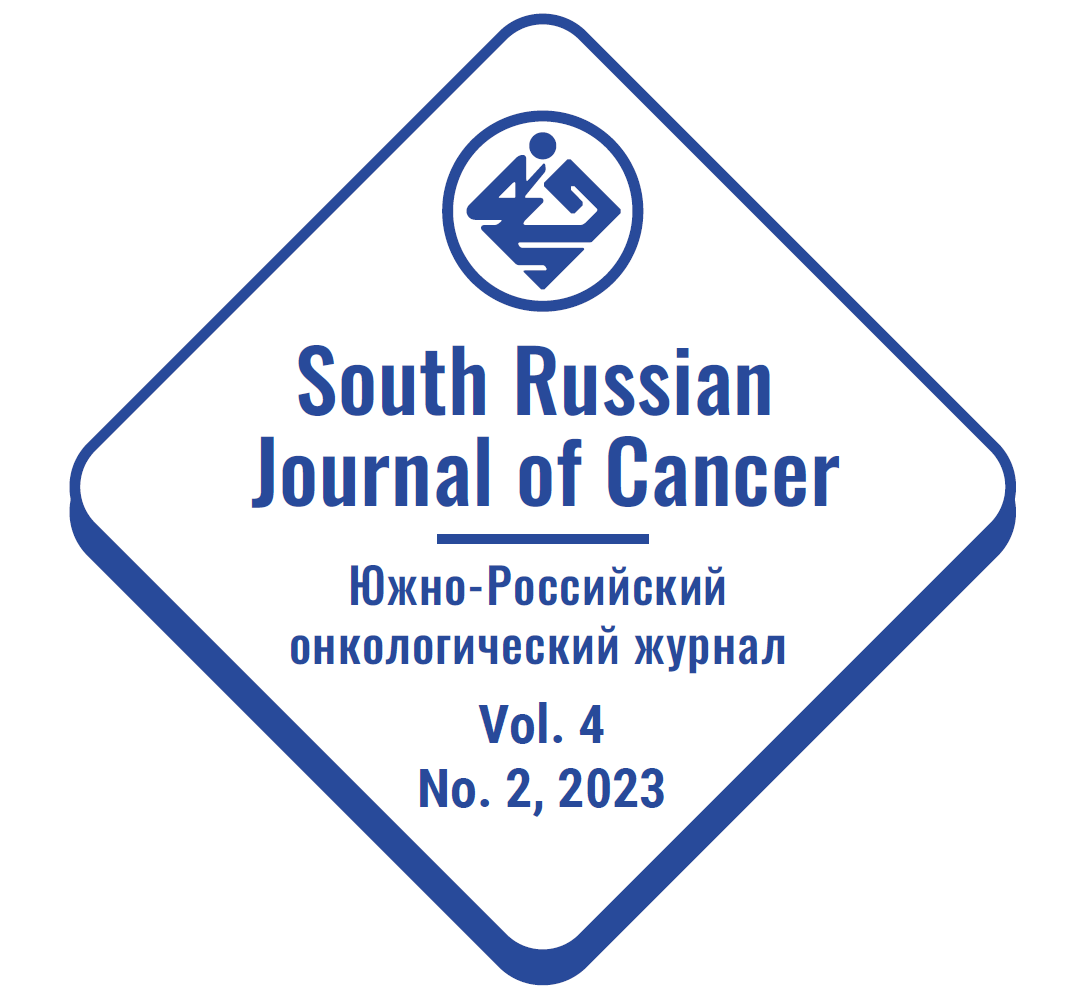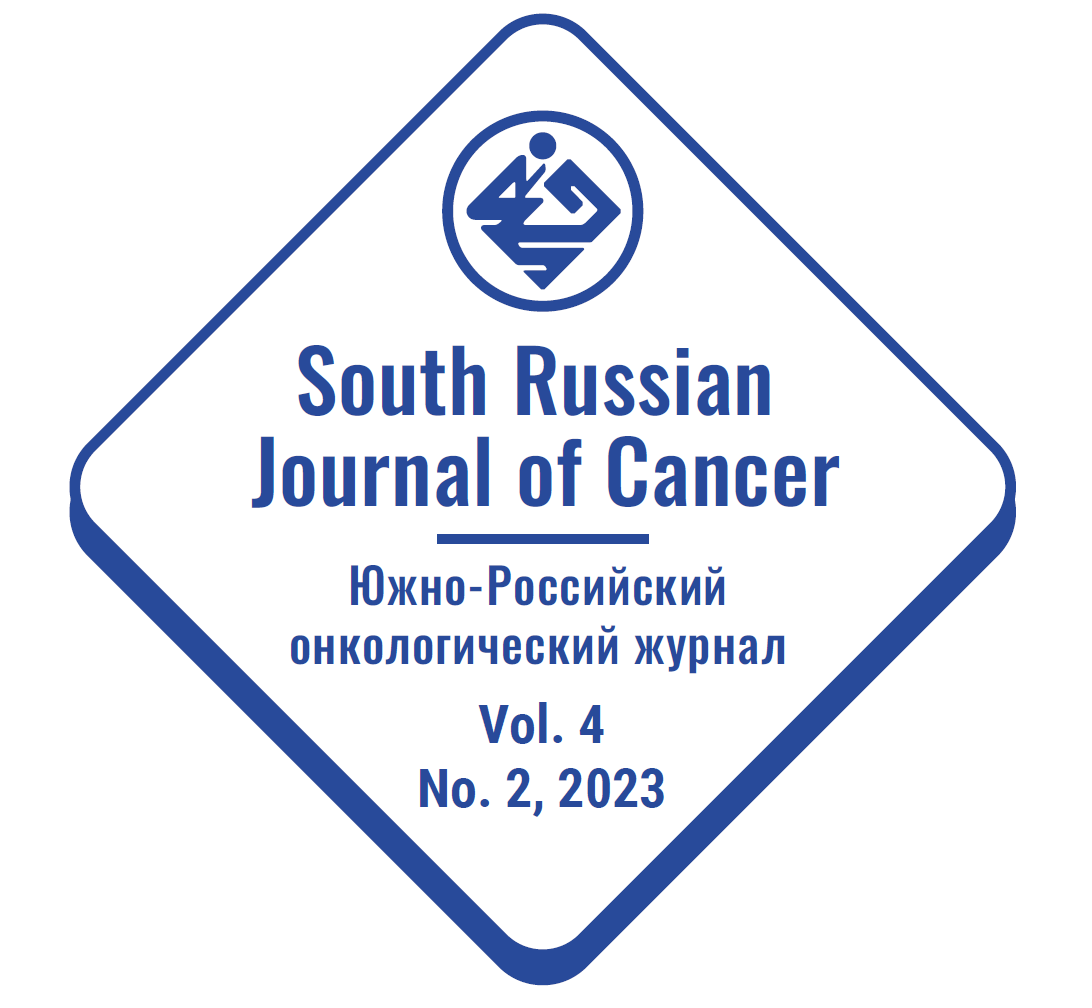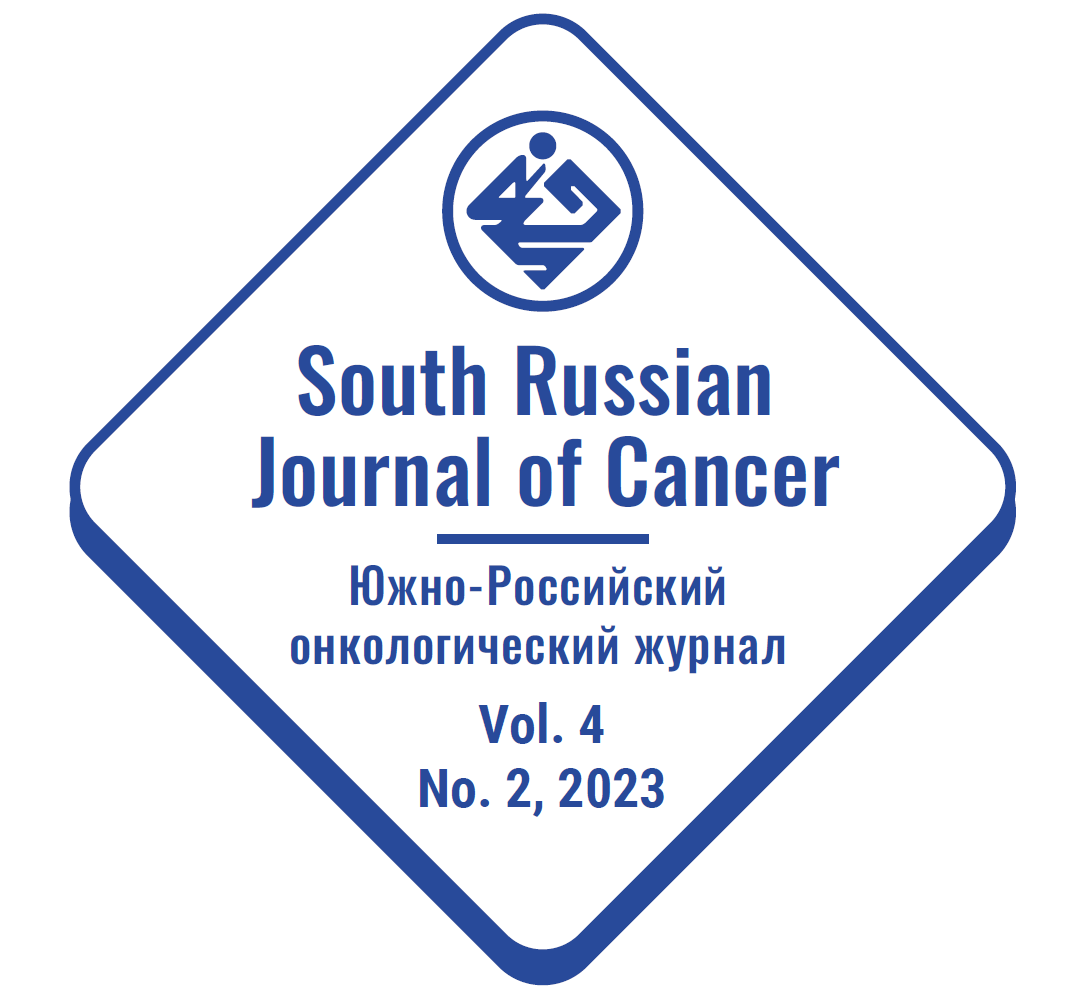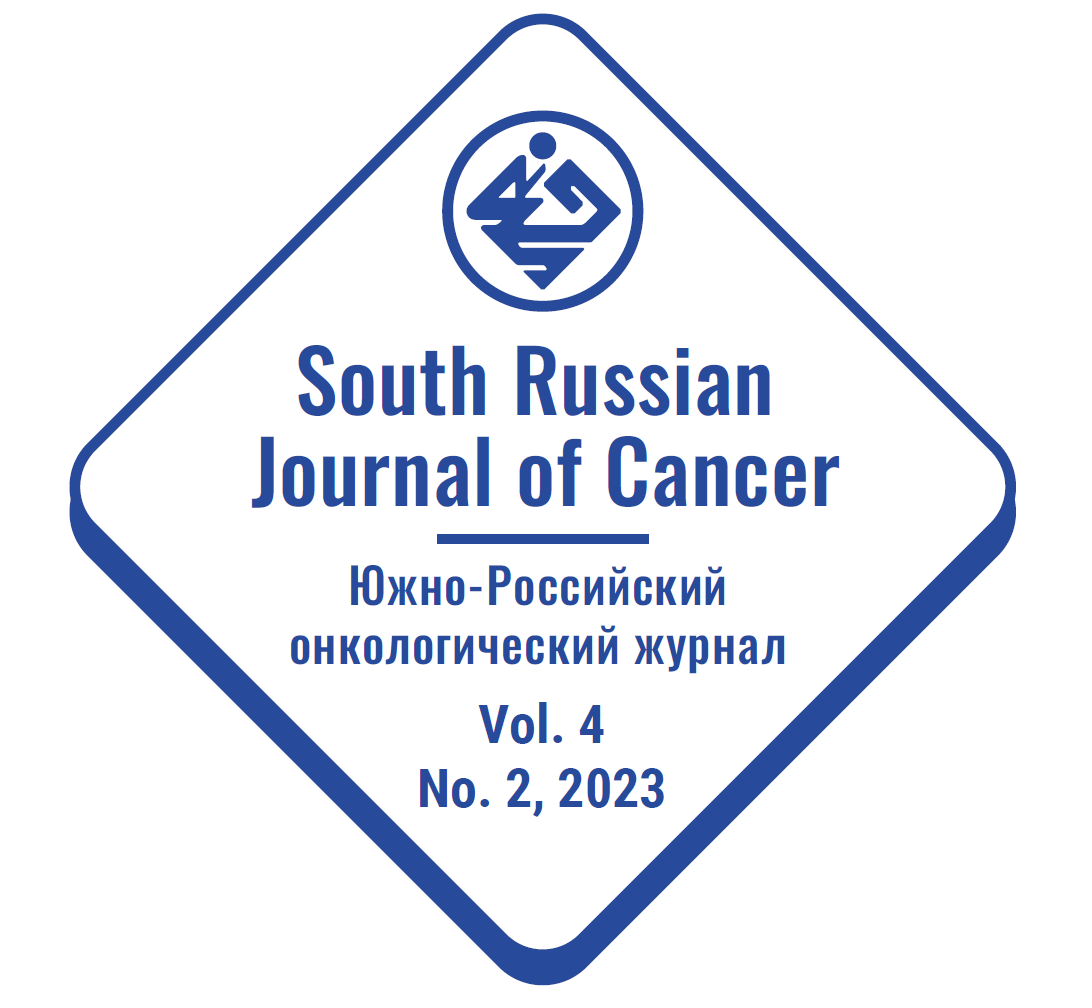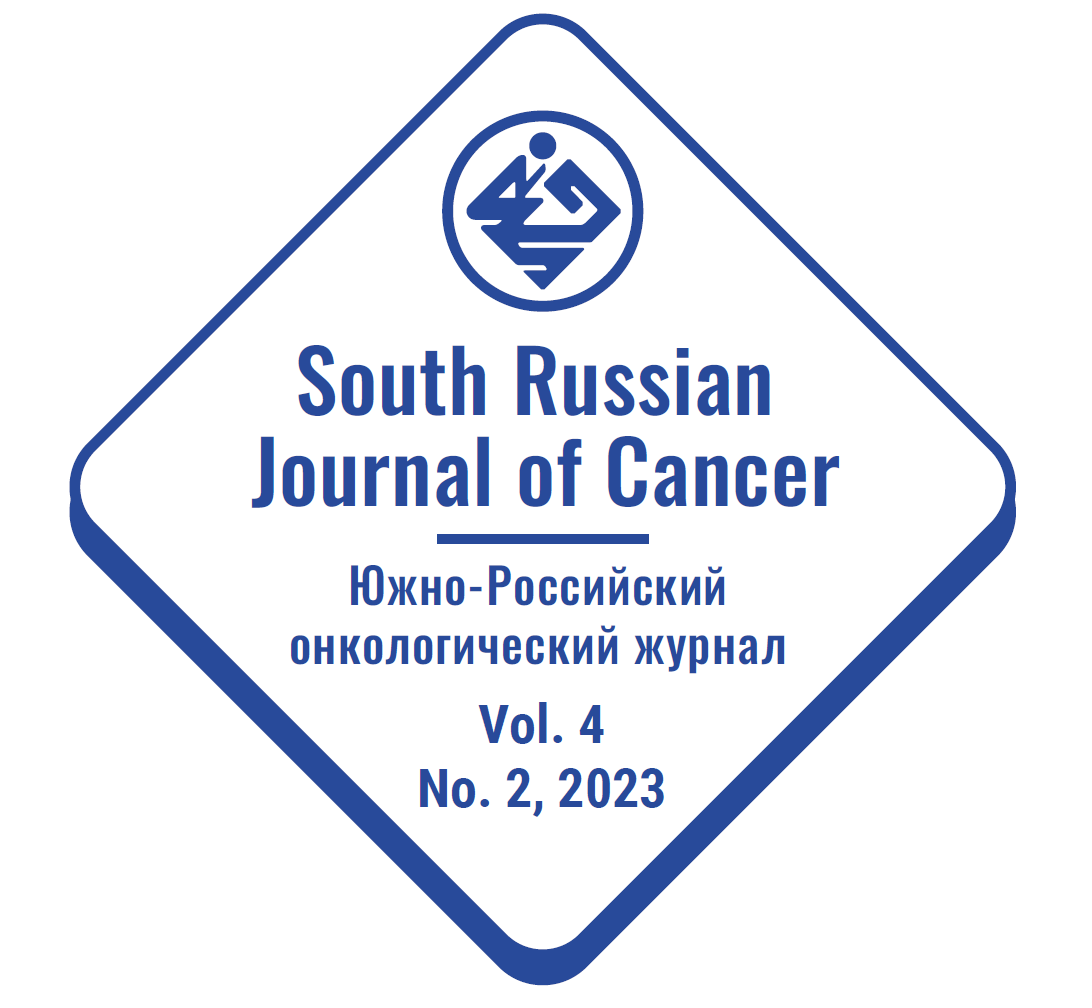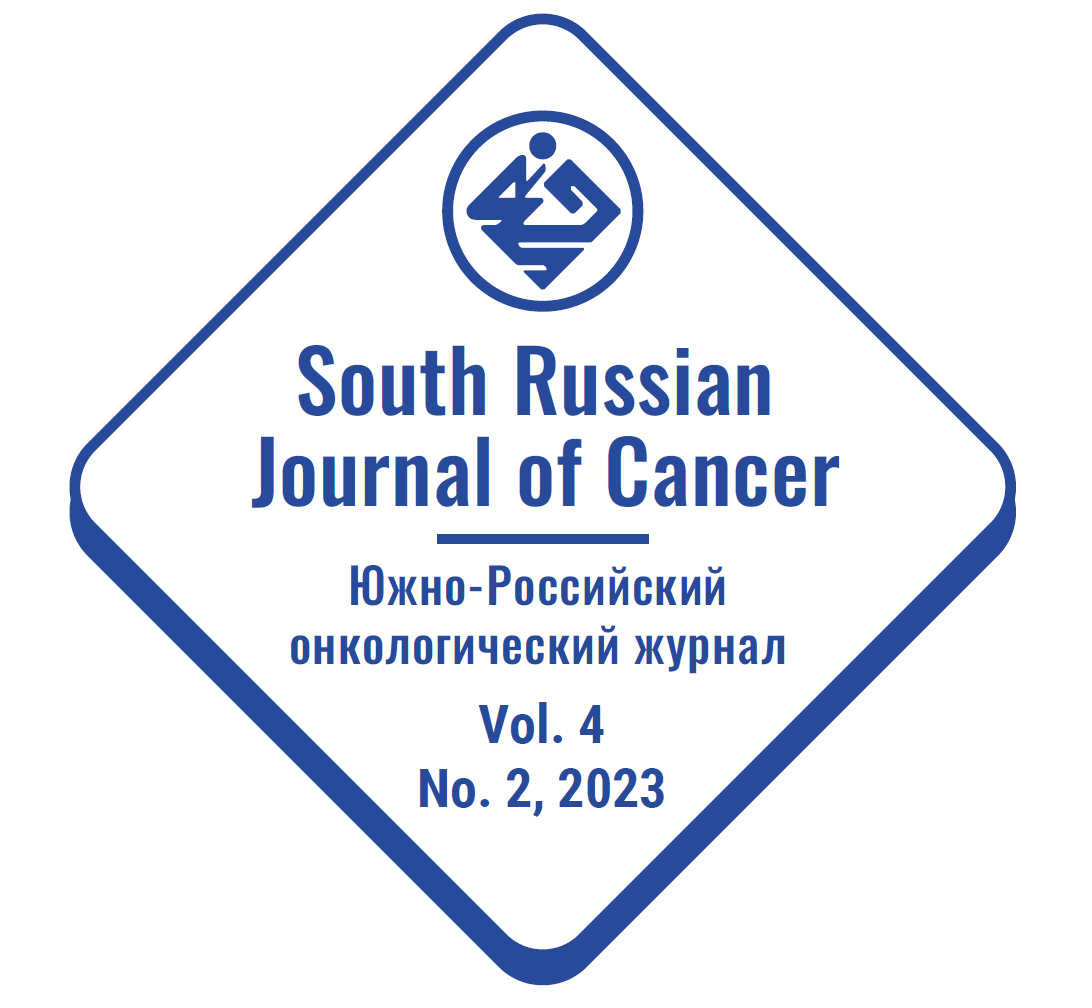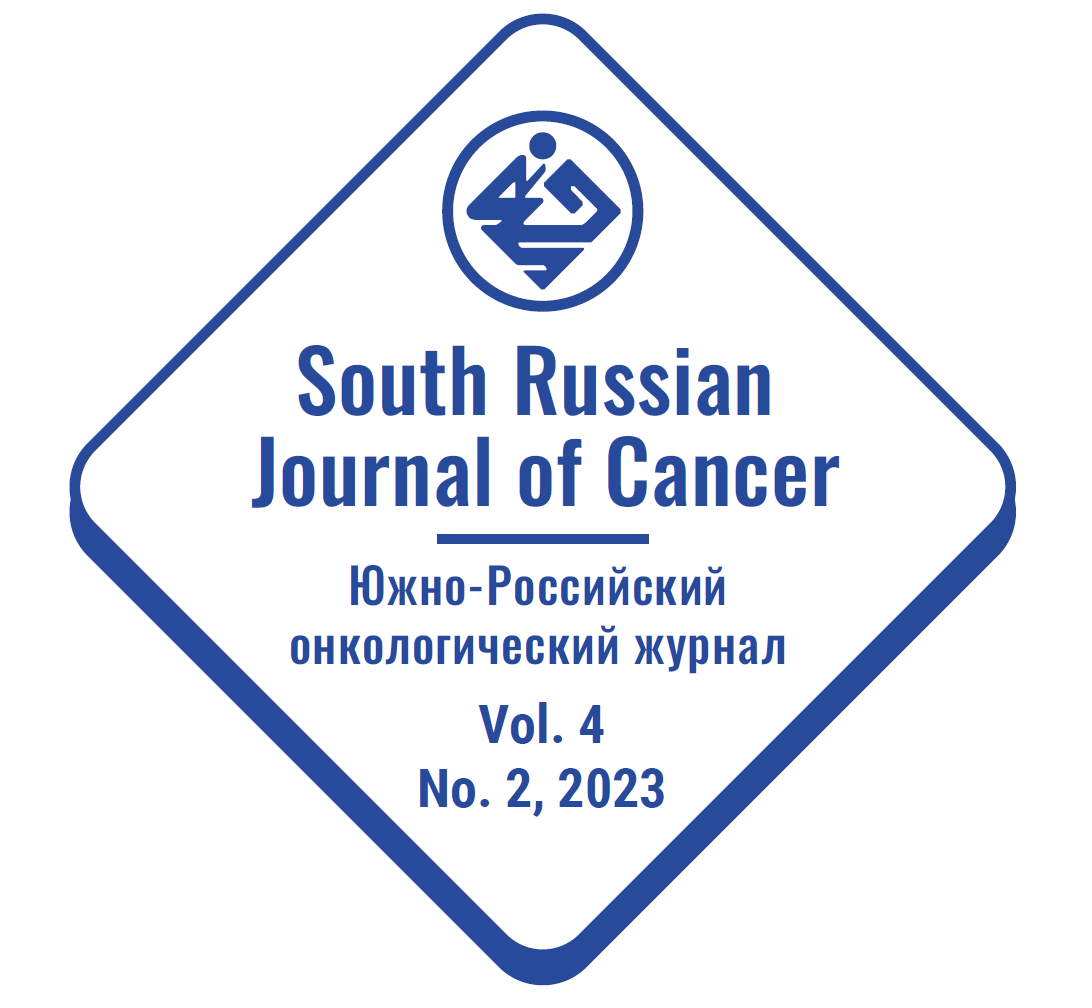ORIGINAL ARTICLES
Purpose of the study. An analysis of IGF and their carrying proteins levels in blood serum of patients with non‑small cell lung cancer (NSCLC), depending on the severity of the previous COVID-19 infection.
Materials and methods. 60 patients with histologically verified NSCLC T2–3NхM0 receiving treatment at the Thoracic Department (National Medical Research Centre for Oncology, 2020–2021), were included in the study. The control group included 30 NSCLC patients after asymptomatic or mild COVID-19 disease (15 men and 15 women); the main group included 30 (15 men and 15 women) patients after severe or moderate to severe COVID-19. The mean age of patients was 59.11 ± 2.89 years. Blood counts of donors of the same age were used as the norm.
Results. The levels of IGF-I, IGF-II, IGFBP2 and IGFBP3 in the blood serum of patients with NSCLC of the main and control groups were higher than those of donors by an average of 2.5, 2.1, 1.7 and 2.7 times, respectively (p < 0.05). The concentration of IGFBP1 was higher in the control group compared to the main group, and decreased in relation to donors: in the control in men and women by 1.4 and 1.9 times, and in the main group by 3.0 and 6.4 times, respectively (p < 0.05). The ratios of IGF and IGFBP1 increased in both groups: IGF-I/IGFBP1 – in the control group from 3.8 to 4.2 times, and in the main group from 7.9 to 14.4 times; IGF-II/IGFBP1 – in the control from 2.4 to 4.5 times, and in the main group from 6.6 to 12.7 times in men and women, respectively (p < 0.05).
Conclusions. The level of ligands and almost all of the studied carrier proteins, except for IGFBP1, increases in the blood of patients with NSCLC of both sexes, regardless of the severity of COVID-19. The ratio of IGF-I/IGFBP1 and IGF-II/IGFBP1 in the blood increases in both groups, most significantly in the group with severe and moderate COVID-19, which indicates excessive accumulation of IGF levels and may contribute to a more aggressive course of the malignant process.
Purpose of the study. Was to analyze levels of biogenic amines (serotonin and its metabolite 5-HIAA, dopamine, norepinephrine and histamine) in lung tissues of patients with lung cancer with previous COVID-19 infection.
Patients and methods. The study was carried out on samples of intact lung tissues, tumor tissues and peritumoral lung tissues obtained during open biopsy while performing radical surgery from patients with morphologically verified non-small cell lung cancer (NSCLC), stage I–IIIA (cT1–3NХM0). The main group included 30 NSCLC patients (15 men and 15 women) after severe or moderate to severe COVID-19 who required hospitalization. The control group included 15 men and 15 women with NSCLC after asymptomatic or mild SARS-CoV-2 infection. The mean age of patients was 59.11 ± 2.9 years. Levels of dopamine, norepinephrine, serotonin, 5-hydroxyindoleacetic acid (5-HIAA) and histamine were measured by ELISA (IBL, Germany).
Results. All studied lung tissue samples from men and women of the main group, compared to the control group, showed deficiency of catecholamines with their ratio unchanged, and changes in serotonin metabolism to ensure its stable level. Thus, levels of dopamine in samples of patients of the main group were lower on average by 1.3 times, norepinephrine by 1.3–3.3 times, serotonin by 1.6 times, and 5-HIAA by 1.8–4 times. At the same time, sex differences were observed in histamine levels. Regardless of the COVID-19 severity, levels of diamine in women were lower in the resection line tissue by an average of 2.4 times, and in the peritumoral tissue by 1.6 times, compared with men, but there were no sex differences in the tumor tissue. Conclusion. Apparently, changes in the levels of dopamine, norepinephrine, and serotonin in lung tissues could be associated with the severity of SARS-CoV-2 infection. Since dopamine is involved in counteracting the carcinogenic action of the adrenergic system and in the regulation of various immunocompetent cells in the tumor microenvironment, such changes in the biogenic status in the lungs of patients of the main group could lead to a more severe tumor course.
Purpose of the study. To analyse free radical oxidation and antioxidant defense in patients diagnosed with early cervical cancer (CC) before and after radical surgical treatment.
Patients and methods. Levels of diene conjugates, malondialdehyde (MDA), superoxide dismutase (SOD), catalase, glutathione, glutathione- dependent enzymes, vitamins A and E were determined in 74 women under the age of 45 (48 patients those who were at the stage of surgical treatment with a diagnosis of CC at the National Medical Research Center of Oncology in the period 2017–2020 and 26 healthy women).
Results. Patients with early CC showed significant changes in the intensity of lipid peroxidation processes and in antioxidant defense: elevate levels of MDA and diene conjugates, initial decline in the activity of SOD and catalase, low levels of vitamins A and E. These results complete the understanding of the processes occurring in the body of an oncological patient at the initial stage of tumor formation, which does not yet have an obvious clinical manifestation. After total removal of the ovaries, most of the indicators characterizing the enzymatic link of the antioxidant system tend to normalize, while the violation of the content of vitamins E and A (related to the non-enzymatic link of the antioxidant system) worsens.
Conclusions. Desynchronization of free radical oxidation processes with multidirectional changes in oxidation and antioxidation in patients with early CC at the stage of radical surgical treatment should be considered from the position of hormone‑ reducing surgery and a resulting complex of changes in the organs and systems of women with cancer.
Purpose of the study. In this work, we have investigated the mechanism of structure formation of GdF3:Tb3+(15 %) nanocrystals synthesized by solvothermal synthesis in the temperature range from RT to 200 °C with a step of 50 °C.
Materials and methods. Nanocrystals of GdF3:Tb3+(15 %) were synthesized by the solvothermal method using a high-pressure reactor (autoclave) designed for temperatures up to 250 °C. The structure, size and morphology were determined by transmission electron microscopy (TEM), the type of crystal lattice and the size of crystallites of nanoparticles were studied by X-ray diffraction (XRD), hydrodynamic size of nanoparticles, particle size distribution, ζ-potential, agglomeration of nanoparticles in colloidal solutions were determined by dynamic light scattering (DLS), the chemical composition of the nanocrystals surface was studied by Fourier-t ransform infra-red spectroscopy (FT-IR), the nanoparticles ability to absorb UV radiation was analyzed by UV-visible spectroscopy (UV-vis) and X-ray excited optical luminescence (XEOL).
Results. With an increase in the temperature of the synthesis reaction, a structural change in the crystallites phase occurs from hexagonal to orthorhombic. At low temperatures, agglomerated particles consisting of hexagonal nanocrystals are formed, while at a temperature higher than the boiling point of the solvent, monodisperse rhombic- shaped nanoparticles with orthorhombic phase are formed. At mild temperatures, agglomerated particles with different morphology and with mixed hexagonal and orthorhombic phases are formed. Based on the analysis of X-ray spectrum, it was found that the size of GdF3:Tb3+(15 %) nanocrystals varies from 10 to 50 nm for different synthesis temperature conditions (T = RT, 50 °C, 100 °C, 150 °C, 200 °C). The hydrodynamic size of nanoparticles decreases with increasing synthesis temperature. All GdF3:Tb3+(15 %) nanocrystals obtained at different temperatures are transparent to visible light and absorb UV radiation. Absorption in the UV region increases with an increase in the size of particle crystallites. Upon X-ray irradiation of the colloidal GdF3:Tb3+(15 %) solution, X-ray excited optical luminescence spectra showed emission peaks at 490 nm, 543 nm, 585 nm and 620 nm.
Conclusion. The mechanism of structure formation of rhombic‑ shaped GdF3:Tb3+(15 %) nanocrystals has been investigated. These monodisperse rhombic- shaped nanoparticles can be used for X-ray induced photodynamic therapy (X-PDT) of superficial, solid and deep-seated tumors.
Purpose of the study. Testing the protocol of obtaining cell spheroids of breast cancer cell cultures for bioprinting by growing in alginate drops.
Materials and methods. Cells of breast cancer cell lines BT-20 and MDA-MB-453 were cultured in DMEM medium supplemented with 10 % FBS. Next, the cells were removed from the plastic using a trypsin-V ersene solution and resuspended in a sterile 2 % alginate solution in DPBS to the concentration of 105 cells/ml. Then the alginate solution with the cells was slowly dripped through a 30G needle into a sterile cooled solution of calcium chloride (100 mM) from a height of 10 cm. After polymerization, alginate drops were washed in DMEM and cultured for two weeks in DMEM with the addition of 10 % FBS at 37 °C and 5.0 % CO2.The spheroids formed in the alginate were photographed on the 3rd, 7th, 10th, and 14th days of cultivation, after which they were removed from the alginate by keeping in 55 mM sodium citrate solution with the addition of 20mM ethylenediaminetetraacetic acid (EDTA) and embedded in paraffin blocks according to the standard method, followed by histological examination.
Results. Cellular spheroids were formed in both cell cultures already on the 3rd day of cultivation. From the 3rd to the 10th day in both cultures, a uniform growth of cell spheroids was observed with a gradual slowdown in the increase in the size of spheroids by the 14th day of cultivation. On the 10th day the proportion of cells that formed clones (more than 500 μm2 in size) was 25.2 % ± 7.1 % (n = 25) in the BT-20 culture and 38.5 % ± 9.9 % (n = 25) in MDA-MB-453 culture. On the 14th day, BT-20 culture was characterized by spheroids varying little in size and shape, with an average area of 1652 ± 175 µm2, having a dense structure with smooth edges. The spheroids in MDA-MB-453 culture turned out to be more loose and easily deformed, their size and shape varied noticeably, the average area of the spheroids was 2785 ± 345 µm2.
Conclusion. The production of spheroids in alginate drops is inferior in speed to the methods of forming cell conglomerates in hanging drops or on microwells, but it surpasses these methods in productivity, which is comparable to the production of spheroids by constant medium stirring on low-adhesive substrates. In addition, the clonal nature of the obtained spheroids leads to an increase in research costs and thus limits their scalability.
CLINICAL CASE REPORTS
The last decade is characterized by significant progress in the treatment of rectal cancer (reduction in the number of relapses to 5–6 % with the use of prolonged radiation therapy) before surgery. The greatest success has been achieved in the treatment of cancer of the lower ampulla of the rectum, when it is possible to develop a complete clinical response of the rectal tumor to chemoradiotherapy. Nevertheless, the requirement issues to improve the results of treatment of cancer of the upper and middle ampullar rectum with an increase in the survival of patients remain. Which makes it relevant to develop new methods, that increase the effectiveness of the treatment of rectal cancer.
The method of modified chemoradiotherapy for cancer of the upper ampulla of the rectum was developed in our study. The method is as follows: at the first stage, one day before the start of radiation therapy, the patient undergoes superselective catheterization of the superior rectal artery through the radial or femoral artery, followed by regional administration of radiomodifying chemotherapy drugs: cisplatin 50 mg and fluorouracil 500 mg. In one day, patients begin to undergo a course of conformal remote large- fraction radiation therapy to the primary focus and metastasis pathways for 5 sessions with a single focal dose of 5 Gy to a total focal dose of 25 Gy using a low-energy linear accelerator. During the entire course of radiation therapy, fluorouracil 500 mg is administered daily intravenously for 30 minutes in 30 minutes before the session. Surgical intervention with the sampling of material for research is carried out 6–8 weeks after the radiation therapy is completed. To assess the effectiveness of the modified chemoradiotherapy, the stage of tumor regression was determined according to the RECIST scale, and the level of therapeutic pathomorphology of the tumor according to Dworak was determined during a morphological study of the rectal tumor removed during the operation.
The developed method of modified chemoradiotherapy makes it possible to achieve regression of the rectal tumor in a short time, reduce the time and increase the effectiveness of treatment. The method of modified chemoradiotherapy is intended for patients with cancer of the upper and middle ampullar rectum T3-4N0-2M0, for whom radiation therapy is indicated as the first stage of treatment, after which resection of the rectum is performed in a standard volume.
Esophageal cancer is one of the most aggressive malignant neoplasms of the gastrointestinal tract, occupying the eighth place in the structure of morbidity worldwide. Despite comprehensive approaches to treatment, mortality continues to grow in both gender groups, which moves this pathology to the sixth position in the structure of mortality from malignant tumors. A lot of patients undergo radiation therapy in the preoperative period or in an independent version due to the peculiarities of the localization of the tumor or the spread of the process. One of the serious complications of the disease on the background of ongoing conservative therapy is perforation of the esophagus, which, according to the literature, can develop from 5.6 to 33 % of cases, and the risk factors for the development of this complication are infiltrative-u lcerative form of cancer, disease stage T3–4 and the presence of esophageal stenosis, as well as the use of chemotherapy drugs such as fluorouracil and cisplatin. The article describes a clinical case of esophageal perforation in a patient with infiltrative-u lcerative form of squamous cell carcinoma of the esophagus on the background of preoperative chemoradiotherapy. The total focal dose (TFD) at the time of complication development was 24 Gy. As a result of a comprehensive additional examination, which revealed a developed complication in the form of perforation of the esophagus, an interdisciplinary council decided on an immediate surgical intervention, during which extirpation of the esophagus with gastro- and esophagostomy was performed. The patient was discharged on the 15th day in a satisfactory condition with a recommendation to conduct an IHC study for the presence of PD-L1 expression to determine further management tactics. This clinical case demonstrates the role of the infiltrative- ulcerative form of tumor growth, the stage of the disease, as well as the use of chemotherapy drugs during radiation treatment as risk factors for the development of esophageal perforation; an important task at the prehospital stage in the selection of such patients is a thorough examination in specialized oncological centers to exclude possible complications in the process of the above conservative treatment.



